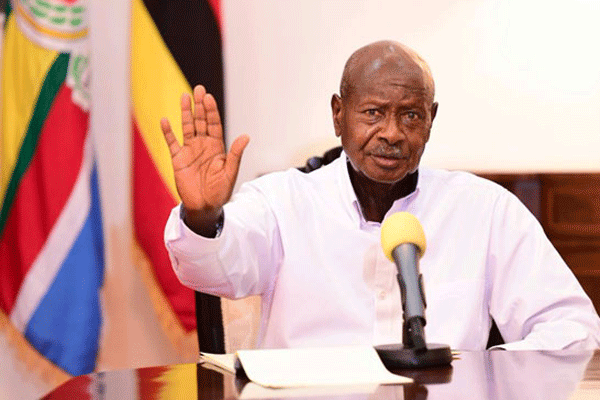Museveni banks on oil, exports in bullish economic growth forecast
Tuesday June 13 2023
Uganda's President Yoweri Museveni. PHOTO | BADRU KATUMBA | AFP
Uganda President Yoweri Museveni has given his most optimistic view of the economy yet, projecting it to grow at an average of 6.5 percent to seven percent per annum in the next five years, banking on manufacturing, increased oil and gas activities, and exports growth — all pegged to the recovering regional and international markets, low inflation, and support to small scale enterprises.
This will push the country’s GDP to $55.2 billion by the end of the 2023/24 financial year — up from the current $49.4 billion — which translates into $156.76 billion in purchasing power parity terms, and take the country’s GDP per capita to $1,186, from $1,096 in the current financial year.
Despite slow recovery of some key sectors like tourism from the Covid-19 effect, the World Bank said in December last year that Uganda is returning to its pre-pandemic path to growth, with economic recovery boosted by the strong performance of the services and industrial sectors, buoyant private consumption, and an uptick in private investment.
And President Museveni remains bullish that Uganda’s economy will expand tenfold, from $55 billion to $550 billion in the short term by exploiting its natural resources and adding value to minerals and high value agricultural products like coffee.
Read: Kenya, Uganda signal recovery on coffee front
“Why? It is because, apart from the said raw materials that are already in place, all the other factors are there. These are an educated workforce, electricity, a better road network, the railway we are about to start building and the old line we are repairing, piped water, telephone lines, the internet,” he said.
Tourism, which was consistently the country’s biggest foreign exchange earner before Covid-19 pandemic, is expected to recover fully in 2025; last year, it registered an increase in international visitor arrivals to 815,000, up from 473,000 in the year 2020, during lockdown.
Data from the sector shows that there is recovery, but the performance is still lower than the 1.543 million tourists recorded in 2019; the data shows leisure and holiday visitors stayed longer (11 nights), in 2022 compared to 7.6 nights in 2019 and spent $172 per night compared to $168 in 2019.
Mr Museveni said in 2022, Uganda’s national parks hosted 367,869 visitors, surpassing pre-Covid-19 levels of 323,861 visitors recorded in 2019, and the sector remains resilient, expected to ride on increased wildlife populations.
The revolving wealth creation fund —referred to as the Parish Development Model (PDM) — which the President campaigned on as the magic bullet to increasing household incomes, remains dodgy, with no countrywide success stories to report in the last two years it has been implemented.
Read: Uganda hits middle income status - Museveni
But Mr Museveni says 60 percent of households have increased their incomes in the year ending December 2022, compared to 43 percent whose incomes increased in the same period a year ago, showing that government’s effort to create wealth at household level, is taking root.
The PDM a grant from of Ush100 million ($26,627) from the government to each registered beneficiary parish savings and credit cooperative per year.
“This is the strategy of PDM, the money is there, cheap and the parish is near. Therefore, no more excuses by the people who want to remain in poverty,” Mr Museveni said.
Key sectors
However, the Ugandan leader took issue with the slow pace of infrastructure growth in the key sectors of the economy, particularly energy and which are supposed to power the country’s industrialisation agenda with lower tariff for manufacturers.
“There are still critical gaps that government will continue to prioritise in order to reduce the cost of doing business, such as lowering the power tariffs for manufacturers and other businesses,” he said.
Uganda’s total installed capacity will jump to 1800MW when the 600 MW Karuma hydropower plant is fully commissioned in the next financial year, but the demand for electricity is increasing by 15 percent per year.
President Museveni said completing heavy investment in the energy sector infrastructure, especially Karuma dam and the associated transmission lines, are a priority to avoid the crisis of generating power without evacuation and distribution infrastructure.
Read: Museveni, Suluhu launch joint power plant in Uganda
President Museveni said completing heavy investment in the energy sector infrastructure, especially Karuma dam and the associated transmission lines, are a priority to avoid the crisis of generating power without evacuation and distribution infrastructure.
Other critical infrastructure expected to drive Uganda’s faster economic growth include railway, development and upgrading of airports, including completion of Kabaale International Airport, which is currently at 91.7 percent completion, Entebbe International Airport expansion upgrade, which is at 71.8 completion as well as development of new ports on the lakes.
